 Image search results - "yogo" Image search results - "yogo" |

Road to Himeji Castle. From Himeji Station, the main road leads to the castle which can be seen in the distance.
|
|

Akashi StationOn the JR Sanyo Line.
|
|

Akashi Castle seen from the train platform of Akashi Station.
|
|

Ryogoku Kokugikan sumo arena as seen from Ryogoku Station
|
|

The Kokugikan as seen from JR Ryogoku Station platform.
|
|
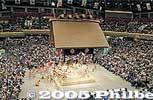
More people than the real tournamentAbout 8,000 people took time out from their Golden Week holidays to see this official sumo practice of all sumo stables.
|
|

Road to Himeji Castle. Otemae Boulevard (Symbol Road). 大手前通り
|
|

Akashi Castle seen from the train platform of Akashi Station.
|
|

Crowd outside the Kokugikan await their favorite wrestlers.
|
|
|

Uchibori Inner Moat
|
|

Crowd enters the Kokugikan for Musashimaru's retirement ceremony on Oct. 2, 2004.
|
|

Yokozuna Deliberation Council membersIn the middle is Kitanoumi.
|
|

Castle moat
|
|

Castle moat
|
|

Passing out programs
|
|
|
|

Path to Otemon Gate, the main gate to the castle. 大手門
|
|

Entrance to Akashi Park
|
|

Musashimaru at the entrance
|
|

Sumo elders in the front row
|
|

Otemon Gate, Main gate to castle. Reconstructed in 1937. 大手門
|
|

Castle moat
|
|

Musashimaru greets the crowd
|
|

Former yokozuna Taiho, Takanosato, Kotozakura, and Wakanohana watch intently.
|
|

World Heritage Site marker. 世界遺産 姫路城
|
|

Twin turrets of Akashi Castle
|
|

Way to Kokugikan. The guarded side gate on the right is for sumo wrestlers.
|
|

Hawaii's last sumo wrestler shakes hands.If he were married, his wife would be beside him.
|
|

Asashoryu greets the council upon entry
|
|

World Heritage Site marker. 世界遺産 姫路城
|
|

Twin turrets of Akashi CastleThe left turret is called the Hitsujisaru Turret (坤櫓) and the right one is called the Tatsumi Turret (巽櫓).
|
|

Taiko drum tower
|
|

Musashimaru right after I shook his hand.
|
|

Asashoryu sips water offered by Ozeki ChiyotaikaiAs soon as Asashoryu entered the arena, many wrestlers went up to him to offer water as a show of respect.
|
|

San no Maru. This area is ringed by cherry trees. 三の丸広場
|
|

Hitsujisaru Turret (坤櫓)
|
|

Taiko drum tower
|
|

Signboard for retirement ceremony at entrance.It reads "Musashimaru, Intai Danpatsu Hiroo Ozumo" which means "Musashimaru Topknot-Cutting and Retirement Sumo Exhibition."
|
|
|

Asashoryu and TochiazumaAfter offering water, Tochiazuma shares a laugh with the yokozuna.
|
|

Special Historical Place marker
|
|

Path to turrets
|
|

Sumo wrestler banners
|
|

Musashigawa stablemaster (former Yokozuna Mienoumi) in the entrance hallInside the entrance hallway, there was a long table on the left side with ribbons which served as name tags for distinguished guests. Musashigawa is the name of Musashimaru's sumo stable.
|
|

JR Ryogoku Station platform for the Sobu Line.
|
|
|

San no Maru cherry trees. The stone marker says that Himeji Castle is one of Japan's 100 Best Cherry Blossom Sites.
|
|

Steps to turrets
|
|

Sumo wrestler and sumo stable banners
|
|
|

Entrance hall is clogged up by a side show of hula.
|
|

Friends after allKyokushuzan chats with fellow Mongolian Asashoryu.
|
|

Castle view from San no Maru.
|
|

Tatsumi Turret (巽櫓)
|
|

Kokugikan
|
|

JR Ryogoku Station 両国駅
|
|

Musashigawa Stable wrestlers greet visitorsIncludes Miyabiyama and Musoyama.
|
|

Practice
|
|

Main castle tower (donjon), called Tenshu. 大天守
|
|

Tatsumi Turret (巽櫓) (not open to visitors)
|
|

Kokugikan ticket office (right). Ticket prices range from 2,100 yen to 14,300 yen.
|
|

JR Ryogoku Station. This part of the station building is now a beer hall. The train station entrance has moved to the right of this.
|
|

In the entrance hall, hula and Hawaiian music direct from Hawaii
|
|
|
|
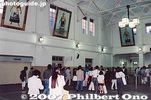
Old entrance to Ryogoku Station with a high ceiling and giant portraits of sumo wrestlers.
|
|

Himeji Castle tower, a National Treasure. 大天守
|
|

Tatsumi Turret (巽櫓)
|
|

Kokugikan ticket office. Cheap tickets costing 2,100 yen are sold every day of the tournament, but sell out fast by noon or so.
|
|

The retirement ceremony had a lot of Hawaiian touches. This was only the beginning.Hula dancers and live Hawaiian band from Hawaii.
|
|

Me next please!!!The winner gets to decide who to wrestle next. The rikishi all beg to be picked.
|
|

Castle tower closeup. 大天守
|
|

Tatsumi Turret (巽櫓)
|
|

Present entrance to Ryogoku Station (during spring festival).
|
|

Gate to enter Kokugikan.
|
|

Konishiki also sings. (His company arranged the entertainment.)
|
|

The Bulgarian (Kotooshu) on the left
|
|

Castle tower, a National Treasure. 大天守
|
|

View from castleThe train station can be seen in the distance.
|
|

At the gate, you might see a famous former wrestler (like former Takamiyama from Hawaii, now Stablemaster Azumazeki) taking your ticket.
|
|

Ryogoku Station exit. Only one sumo portait hangs here.
|
|

Musashigawa Stable wrestler wearing Aloha-print yukataFlowery pattern (plumeria) with "Musashimaru" imprinted.
|
|
|

Castle wall and Hitsujisaru Turret (坤櫓)
|
|

Map of Ryogoku. The Kokugikan sumo arena is north of the station, as well as the Edo-Tokyo Museum.
|
|

Front of Kokugikan. The wide stairs make it quick for many people to exit the building. It is a sleek, modern building with a spacious interior. The roof collects rainwater for use in the toilets.
|
|

Musashimaru souvenirs at the Kokugikan's souvenir shop
|
|

Ready to pounce on the winner
|
|
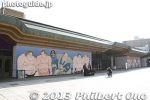
After you go through the ticket gate, the front of Kokugikan has two large murals.
|
|

Castle ticket office and entrance. Admission is 600 yen for adults. Hours are 9:00 a.m. to 4:00 p.m. (September through May) or 9:00 a.m. to 5:00 p.m.(June through August).
|
|

Hitsujisaru Turret (坤櫓) is open to visitors.
|
|

Musashimaru merchandise
|
|
|
|
|
|
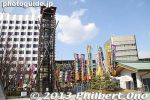
Taiko drum tower
|
|
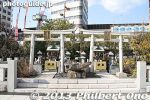
Two small shrines outside.
|
|
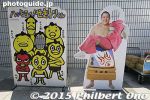
Pose with a cutout of popular rikishi Endo.
|
|
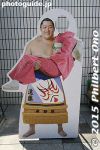
Pose with a cutout of popular rikishi Endo.
|
|
|

Path to Hishi Gate. 菱門
|
|

Castle tower foundation
|
|

Musashimaru doll
|
|

Asashoryu joins in
|
|

Hishi Gate, Important Cultural Property. Pass though this large gate to proceed to the Ni no Maru compound. 菱門
|
|

Hitsujisaru Turret (坤櫓) and castle tower foundation
|
|

Sumo wrestlers enter through a side entrance. Fans wait for their favorite wrestlers.
|
|
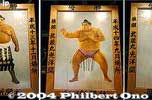
Giant painted pictures of Musashimaru decorating the arena inside. Each one commemorates a tournament victory.These giant pictures are actually black-and-white photographs taken in a photo studio and printed on large paper. Then it is hand-painted in color by a woman who has been doing it for years.
|
|
|
|

View from the right of Hishi Gate
|
|

Inside Hitsujisaru Turret
|
|

Entrance lobby. At the end of the lobby is a trophy showcase. On the last day of the tournament, the tournament winner will walk through here to his car for a victory parade amid a large crowd.
|
|

The ceremony opens with taiko drum beating on the sumo ring.
|
|

Both ozeki watch
|
|

View from the right of Hishi Gate
|
|

Inside Hitsujisaru Turret
|
|

Side of lobby. (Passing out free calendar posters during Jan. tourney.)
|
|

Sumo exhibition matches with lower division Makushita wrestlers.A retirement ceremony for an important sumo wrestler includes a variety of activities besides the actual ceremony of cutting away the topknot. It involves almost the entire Japan Sumo Association, and most wrestlers in the top three divisions (Makushita, Juryo, and Makunouchi) also appear in exhibition matches.
|
|
|

Ni no Maru. After passing through Hishi Gate, this is what you see.
|
|

Inside Hitsujisaru Turret
|
|

Sumo mural in lobby.
|
|

Makushita sumo matchLower-division wrestlers wear black belts, while the upper division wrestlers wear white belts (during practice) or colored belts during official matches.
|
|
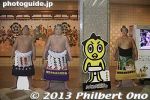
In the entrance hall are life-size cutouts of the top wrestlers.
|
|
|
|
|

Inside Hitsujisaru TurretRoof tile ends on display.
|
|

Trophy case in lobby. This is the Emperor's Cup awarded to the tournament winner.
|
|

Juryo Division dohyo-iri ring-entering ceremony
|
|

BreakAsashoryu took a water break between each practice bout.
|
|

Sangoku Moat in Ni no Maru, 三国堀
|
|

Stairs inside Hitsujisaru TurretUnfortunately, the upper floor is bnot open to visitors.
|
|

Emperor's Cup. This is what all sumo wrestlers dream about.
|
|

Juryo sumo match
|
|
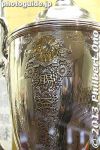
Closeup of Emperor's Cup.
|
|

I'm waiting...
|
|

I-no-mon Gate (Important Cultural Asset) いの門
|
|

View from Hitsujisaru Turret
|
|

Nameplates of tournament winners on Emperor's Cup
|
|

Hairdressing demonstration
|
|
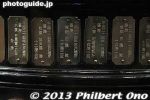
Closeup of nameplates of tournament winners on Emperor's Cup.
|
|
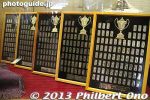
Old Nameplates of tournament winners that were on the Emperor's Cup.
|
|
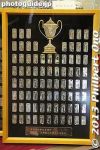
Old Nameplates of tournament winners that were on the Emperor's Cup.
|
|
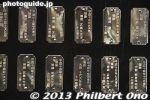
Closeup of old Nameplates of tournament winners that were on the Emperor's Cup.
|
|

Asashoryu gets thrown
|
|

Ro-no-mon Gate (Important Cultural Asset) ろの門
|
|

Castle wall
|
|
|

Sumo match with kidsA retirement ceremony for an important sumo wrestler includes a variety of activities besides the actual ceremony of cutting away the topknot. It involves almost the entire Japan Sumo Association, and most wrestlers in the top three divisions (Makushita, Juryo, and Makunouchi) also appear in exhibition matches.
|
|
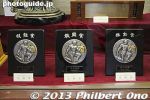
Plaques for the Three Outstanding Prizes (Technique, Outstanding Performance, and Fighting Spirit) awarded by two newspapers.Technique Prize (Gino-sho), Outstanding Performance (for most Yokozuna/Ozeki upsets, Shukun-sho), and Fighting Spirit (Kanto-sho).
|
|
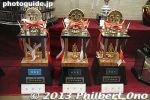
Trophies for the Three Outstanding Prizes (Technique, Outstanding Performance, and Fighting Spirit) from the Japan Sumo Association.Technique Prize (Gino-sho), Outstanding Performance (for most Yokozuna/Ozeki upsets, Shukun-sho), and Fighting Spirit (Kanto-sho).
|
|

A "darn it" look on his face
|
|

Path to Ha-no-mon Gate はの門
|
|

Garden of Musashi 武蔵の庭園Near the park entrance is a Japanese garden designed by Miyamoto Musashi, famous warrior.
|
|

The tournament winner receives numerous prizes from various organizations and companies.
|
|

A retirement ceremony for an important sumo wrestler includes a variety of activities besides the actual ceremony of cutting away the topknot. It involves almost the entire Japan Sumo Association, and most wrestlers in the top three divisions (Makushita, Juryo, and Makunouchi) also appear in exhibition matches.
|
|
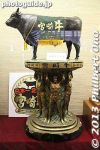
Prize from Miyazaki Prefecture.
|
|
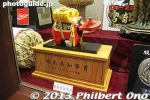
Prize from Fukushima Prefecture.
|
|
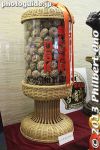
Mushrooms from Oita Prefecture.
|
|
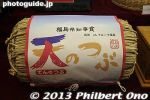
Another prize from Fukushima Prefecture.
|
|
|
|
|

Path to Ni-no-mon Gate
|
|

Statue of Nakabe Ikujiro (1866-1946) 中部幾次郎A pioneer in building up Akashi's fisheries industry. Also a philanthropist who donated money to build schools in Akashi.
|
|

Prime Minister's Cup on left, the middle is the President Chirac Award from France, and the glass on the right is a prize from the Czech Republic.President Chirac is a sumo fan. There is also a Czech wrestler in the lower division.
|
|
|

Butsuri keiko
|
|

Ni-no-mon Gate (Important Cultural Asset) にの門
|
|

Statue of Nakabe Ikujiro (1866-1946) 中部幾次郎A pioneer in building up Akashi's fisheries industry. Also a philanthropist who donated money to build schools in Akashi.
|
|

Prize from the United Arab Emirates.
|
|

Edo-Tokyo Museum
|
|

The kids gradually get bigger.
|
|

Takamisakari for butsuri keikoEverybody cheered whenever he entered the ring.
|
|

Yokozuna statue
|
|

Inside Ni-no-mon Gate. A bottleneck gate designed so not many enemy soldiers can pass through at one time.
|
|

Map of Akashi ParkThe castle is now only a small part of the park.
|
|

In the back on the left is a prize from Mexico and one from Hungary on the right. In the front on the left is a prize from Mongolia, middle is from NHK, and right is from China.
|
|

Ozeki Musoyama is defeated.
|
|

Ho-no-mon Gate (lower left)
|
|

Mizu-no-ichi Gate, Important Cultural Property.
|
|

Mizu-no-ni Gate, Important Cultural Property
|
|

Mizu-no-san Gate
|
|

Asashoryu exchanges a few wordsAfter the practice was over at 11 am, the sole yokozuna went over to the council.
|
|

Castle roof underside
|
|

Shop selling sumo goods.
|
|

Sumo Museum. Open only during tournament days. Free admission.The wall on the left show portraits of all the yokozuna in the modern era.
|
|

Yobidashi wearing Aloha-print garb
|
|
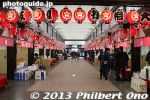
Sumo service entrance for groups.
|
|

Finish, everybody out please...
|
|

Storehouse
|
|

Tatsunami-beya sumo stable.
|
|

Corridor and souvenir shops.A corridor encircles the arena.
|
|
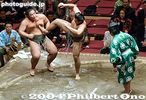
Comic sumo (shokkiri sumo)This is comedy time with two young wrestlers performing various comical antics (spitting at each other, kicking, and other illegal sumo acts) on the ring.
|
|

Koshi no Kuruwa storehouse for rice and salt
|
|

Sumo figurines.
|
|

Comic sumo (shokkiri sumo)This is comedy time with two young wrestlers performing various comical antics (spitting at each other, kicking, and other illegal sumo acts) on the ring.
|
|
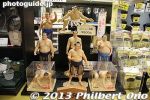
Sumo figurines.
|
|
|
|
|
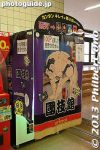
Print Club photo sticker booth.
|
|

Inside storehouse
|
|

Kokugikan Cafe snack bar
|
|

Tidying up the ring
|
|

Family crest on roof tiles. The family crest of the resident warlords who repaired the castle remain on the roof.
|
|

Bios and pictures of all sumo wrestlers in top Makunouchi division.
|
|

Musashimaru finally appears for a yokozuna belt demo
|
|

The family crest of the resident warlords who repaired the castle are displayed. The warlords include Hashiba (later Toyotomi) Hideyoshi, Ikeda Terumasa, Honda Tadamasa, Matsudaira Tadaaki, Matsudaira Naomoto, Sakakibara Tadatsugu, and Sakai Tadazumi.
|
|

The bios and pictures are categorized according to prefecture. All wrestlers who were/are active in the modern era are introduced. Two wrestlers from Shiga Prefecture: Kurama and Misugisato.
|
|

Musashimaru acknowledges a spectator as he proceeds to the ring.This was a demonstration on how they tie on the thick, white rope (tsuna) around his waist. The tsuna is the symbol of the yokozuna. It takes several assistants to put it on. They are all wearing white gloves.
|
|

The family crest of the resident warlords who repaired the castle remain on the roof.
|
|

Non-Japanese sumo wrestlers who made it to Makunouchi Division. Four from USA (Hawaii), four from Mongolia, and one from Bulgaria (Kotooshu) as of 2006.
|
|

Yokozuna "tsuna" belt demo
|
|

Koshi Kuruwa storehouse (Waist Quarter) for salt and rice.
|
|

Bulgaria (Kotooshu)
|
|

They wrap the rope around his waist from the front, or the thickest part of the rope.This was a demonstration on how they tie on the thick, white rope (tsuna) around his waist. The tsuna is the symbol of the yokozuna. It takes several assistants to put it on. They are all wearing white gloves.
|
|
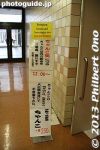
Entrance to the dining room for chanko-nabe. It's downstairs in the basement.
|
|

Inside storehouse
|
|

Pulling it tight
|
|

The chanko-nabe menu changes a few times during the tournament. The recipes are from various sumo stables.
|
|

He-no-mon Gate への門
|
|
|
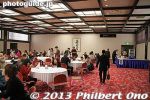
The banquet hall in the basement is used as a dining room during lunch time during tournaments. 大広間
|
|

View from He-no-mon Gate
|
|

Tying the rope at the back.
|
|
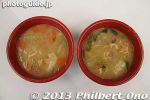
I usually eat two bowls. Only 250 yen per bowl.
|
|

Chi-no-mon Gate in the distance. On the left partially hidden is To-no-ichi Gate. ちの門
|
|

Rear view of the shiranui style of tying the rope.He turned in all four directions to show everyone what it looked like. This is what is called the shiranui style of tying the rope. It is characterized by a single loop in the back. The other style, called unryu, has twin loops.
|
|

It is really good! Different flavors are offered during different days of the tournament. Top is shoyu (soy sauce) flavor, and bottom is salt flavor. Miso flavor is also offered.
|
|

To-no-ichi Gate との一問
|
|

Musashimaru goes back and then comes back...
|
|

Lecture classroom (previously used as a dining room for chanko-nabe during tournaments). 相撲教習所
|
|

One end of To-no-ichi Gate
|
|

Next to the chanko dining room is a sumo ring for practice and deliberation exhibition matches.
|
|
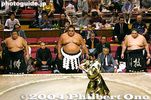
He performs his last yokozuna dohyo-iri ring-entering ceremony. He is flanked by Musoyama on the left as the sword bearer, and Miyabiyama on the right as the dew sweeper.
|
|

The sign reads "Physical body, Technique, Heart." What you need to succeed in sumo.
|
|

View of castle tower from Chi-no-mon Gate
|
|

Musashimaru's final dohyo-iriHe could have had Yokozuna Asashoryu be either the sword bearer or dew sweeper, but he chose to have his stablemates to join his final dohyo-iri.
|
|
|

He-no-mon Gate in the distance. As seen from Chi-no-mon Gate.
|
|

Musashimaru's final dohyo-iri
|
|

Chi-no-mon Gate (after passing through)
|
|

Door to arena.
|
|

Musashimaru's final dohyo-iri
|
|
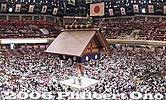
Panorama shot of sumo arena during a sumo tournament. There are two levels.
|
|

Well Turret sign. The turret is to defend the rear of the castle. It has three rooms, one of which has a 16-meter deep well. 井郭櫓
|
|

Musashimaru's final dohyo-iri
|
|

Well Turret. The well is 16 meters deep with water 1 meter deep.
|
|

This is the lower level with zabuton box seats costing over 10,000 yen.
|
|

Musashimaru's final dohyo-iri ends
|
|

Bizen Gate entrance to Honmaru, also called Bizen-maru. Notice the coffin stone on the right of the gate. (Important Cultural Property) 備前門
|
|

Box seats. Cramped space for four people.
|
|
| 1763 files on 7 page(s) |
1 |
 |
 |
 |
 |
|